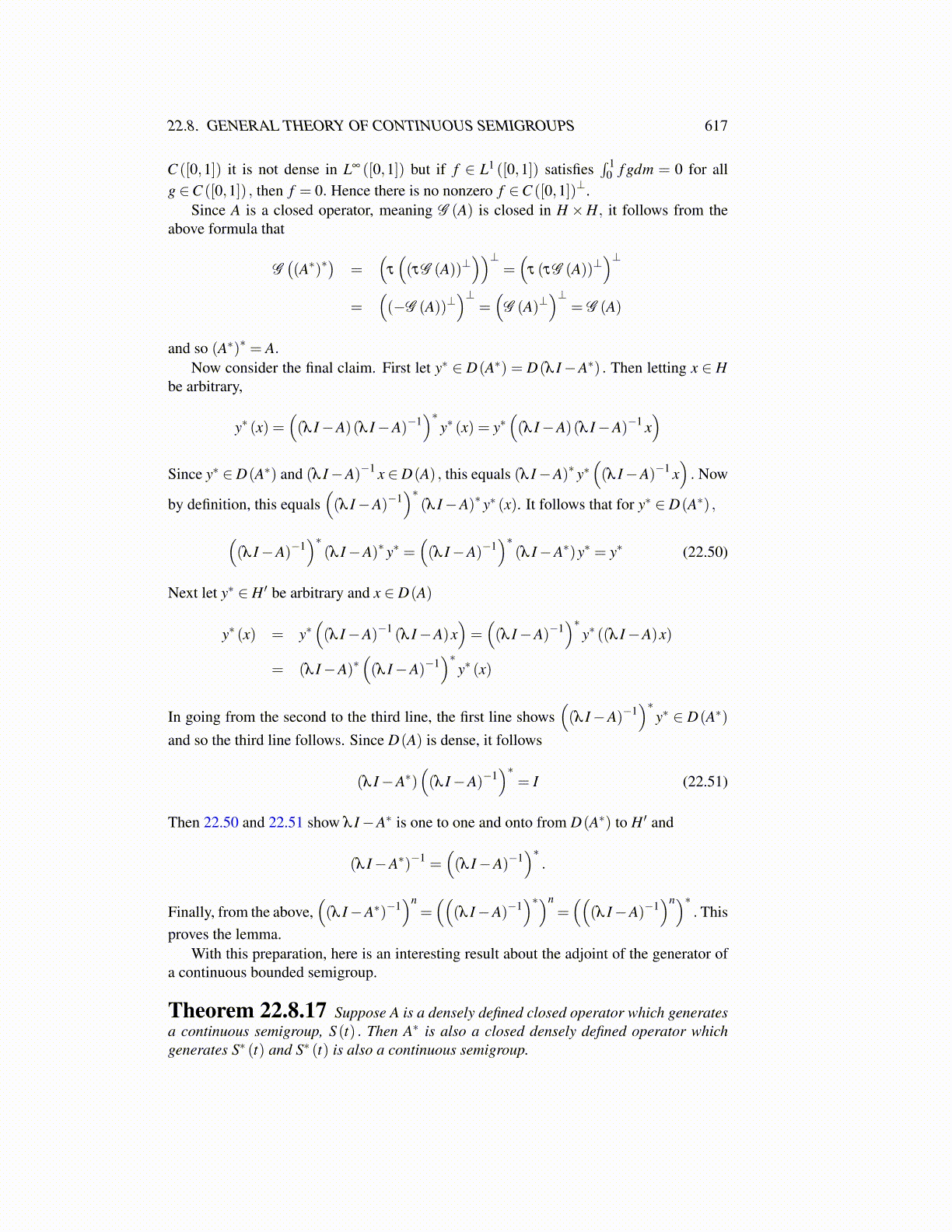
22.8. GENERAL THEORY OF CONTINUOUS SEMIGROUPS 617
C ([0,1]) it is not dense in L∞ ([0,1]) but if f ∈ L1 ([0,1]) satisfies∫ 1
0 f gdm = 0 for allg ∈C ([0,1]) , then f = 0. Hence there is no nonzero f ∈C ([0,1])⊥.
Since A is a closed operator, meaning G (A) is closed in H ×H, it follows from theabove formula that
G((A∗)∗
)=
(τ
((τG (A))⊥
))⊥=(
τ (τG (A))⊥)⊥
=((−G (A))⊥
)⊥=(G (A)⊥
)⊥= G (A)
and so (A∗)∗ = A.Now consider the final claim. First let y∗ ∈ D(A∗) = D(λ I−A∗) . Then letting x ∈ H
be arbitrary,
y∗ (x) =((λ I−A)(λ I−A)−1
)∗y∗ (x) = y∗
((λ I−A)(λ I−A)−1 x
)Since y∗ ∈D(A∗) and (λ I−A)−1 x ∈D(A) , this equals (λ I−A)∗ y∗
((λ I−A)−1 x
). Now
by definition, this equals((λ I−A)−1
)∗(λ I−A)∗ y∗ (x). It follows that for y∗ ∈ D(A∗) ,
((λ I−A)−1
)∗(λ I−A)∗ y∗ =
((λ I−A)−1
)∗(λ I−A∗)y∗ = y∗ (22.50)
Next let y∗ ∈ H ′ be arbitrary and x ∈ D(A)
y∗ (x) = y∗((λ I−A)−1 (λ I−A)x
)=((λ I−A)−1
)∗y∗ ((λ I−A)x)
= (λ I−A)∗((λ I−A)−1
)∗y∗ (x)
In going from the second to the third line, the first line shows((λ I−A)−1
)∗y∗ ∈ D(A∗)
and so the third line follows. Since D(A) is dense, it follows
(λ I−A∗)((λ I−A)−1
)∗= I (22.51)
Then 22.50 and 22.51 show λ I−A∗ is one to one and onto from D(A∗) to H ′ and
(λ I−A∗)−1 =((λ I−A)−1
)∗.
Finally, from the above,((λ I−A∗)−1
)n=((
(λ I−A)−1)∗)n
=((
(λ I−A)−1)n)∗
. Thisproves the lemma.
With this preparation, here is an interesting result about the adjoint of the generator ofa continuous bounded semigroup.
Theorem 22.8.17 Suppose A is a densely defined closed operator which generatesa continuous semigroup, S (t) . Then A∗ is also a closed densely defined operator whichgenerates S∗ (t) and S∗ (t) is also a continuous semigroup.